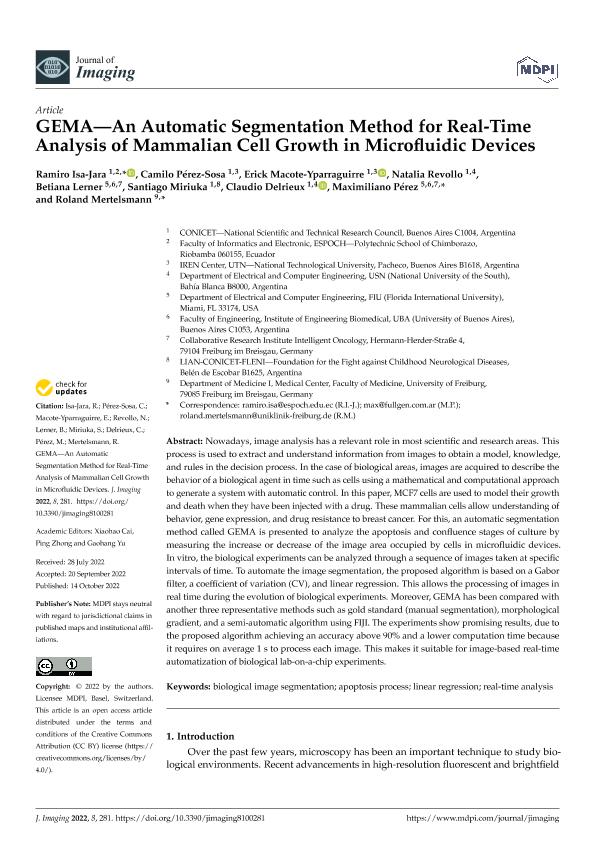Mostrar el registro sencillo del ítem
dc.contributor.author
Isa Jara, Ramiro Fernando

dc.contributor.author
Pérez Sosa, Camilo José

dc.contributor.author
Macote Yparraguirre, Erick Leonel

dc.contributor.author
Revollo Sarmiento, Natalia Veronica

dc.contributor.author
Lerner, Betiana

dc.contributor.author
Miriuka, Santiago Gabriel

dc.contributor.author
Delrieux, Claudio Augusto

dc.contributor.author
Pérez, Maximiliano
dc.contributor.author
Mertelsmann, Roland

dc.date.available
2023-07-25T01:53:18Z
dc.date.issued
2022-10-14
dc.identifier.citation
Isa Jara, Ramiro Fernando; Pérez Sosa, Camilo José; Macote Yparraguirre, Erick Leonel; Revollo Sarmiento, Natalia Veronica; Lerner, Betiana; et al.; GEMA—An Automatic Segmentation Method for Real-Time Analysis of Mammalian Cell Growth in Microfluidic Devices; I S & T - Soc Imaging Science Technology; Journal Of Imaging Science And Technology; 8; 10; 14-10-2022; 1-18
dc.identifier.issn
1062-3701
dc.identifier.uri
http://hdl.handle.net/11336/205127
dc.description.abstract
Nowadays, image analysis has a relevant role in most scientific and research areas. This process is used to extract and understand information from images to obtain a model, knowledge, and rules in the decision process. In the case of biological areas, images are acquired to describe the behavior of a biological agent in time such as cells using a mathematical and computational approach to generate a system with automatic control. In this paper, MCF7 cells are used to model their growth and death when they have been injected with a drug. These mammalian cells allow understanding of behavior, gene expression, and drug resistance to breast cancer. For this, an automatic segmentation method called GEMA is presented to analyze the apoptosis and confluence stages of culture by measuring the increase or decrease of the image area occupied by cells in microfluidic devices. In vitro, the biological experiments can be analyzed through a sequence of images taken at specific intervals of time. To automate the image segmentation, the proposed algorithm is based on a Gabor filter, a coefficient of variation (CV), and linear regression. This allows the processing of images in real time during the evolution of biological experiments. Moreover, GEMA has been compared with another three representative methods such as gold standard (manual segmentation), morphological gradient, and a semi-automatic algorithm using FIJI. The experiments show promising results, due to the proposed algorithm achieving an accuracy above 90% and a lower computation time because it requires on average 1 s to process each image. This makes it suitable for image-based real-time automatization of biological lab-on-a-chip experiments.
dc.format
application/pdf
dc.language.iso
eng
dc.publisher
I S & T - Soc Imaging Science Technology

dc.rights
info:eu-repo/semantics/openAccess
dc.rights.uri
https://creativecommons.org/licenses/by-nc-sa/2.5/ar/
dc.subject
APOPTOSIS PROCESS
dc.subject
BIOLOGICAL IMAGE SEGMENTATION
dc.subject
LINEAR REGRESSION
dc.subject
REAL-TIME ANALYSIS
dc.subject.classification
Física de los Fluidos y Plasma

dc.subject.classification
Ciencias Físicas

dc.subject.classification
CIENCIAS NATURALES Y EXACTAS

dc.title
GEMA—An Automatic Segmentation Method for Real-Time Analysis of Mammalian Cell Growth in Microfluidic Devices
dc.type
info:eu-repo/semantics/article
dc.type
info:ar-repo/semantics/artículo
dc.type
info:eu-repo/semantics/publishedVersion
dc.date.updated
2023-07-06T17:24:56Z
dc.journal.volume
8
dc.journal.number
10
dc.journal.pagination
1-18
dc.journal.pais
Suiza

dc.description.fil
Fil: Isa Jara, Ramiro Fernando. Escuela Superior Politécnica de Chimborazo; Ecuador. Consejo Nacional de Investigaciones Científicas y Técnicas; Argentina
dc.description.fil
Fil: Pérez Sosa, Camilo José. Consejo Nacional de Investigaciones Científicas y Técnicas; Argentina. Universidad Tecnológica Nacional; Argentina
dc.description.fil
Fil: Macote Yparraguirre, Erick Leonel. Universidad Tecnológica Nacional; Argentina. Consejo Nacional de Investigaciones Científicas y Técnicas; Argentina
dc.description.fil
Fil: Revollo Sarmiento, Natalia Veronica. Consejo Nacional de Investigaciones Científicas y Técnicas; Argentina. Universidad Nacional del Sur; Argentina. Consejo Nacional de Investigaciones Científicas y Técnicas. Centro Científico Tecnológico Conicet - Bahía Blanca. Instituto de Investigaciones en Ingeniería Eléctrica "Alfredo Desages". Universidad Nacional del Sur. Departamento de Ingeniería Eléctrica y de Computadoras. Instituto de Investigaciones en Ingeniería Eléctrica "Alfredo Desages"; Argentina
dc.description.fil
Fil: Lerner, Betiana. Florida International University; Estados Unidos. Universidad de Buenos Aires; Argentina. Consejo Nacional de Investigaciones Científicas y Técnicas; Argentina
dc.description.fil
Fil: Miriuka, Santiago Gabriel. Consejo Nacional de Investigaciones Científicas y Técnicas; Argentina. Fundación para la Lucha contra las Enfermedades Neurológicas de la Infancia; Argentina
dc.description.fil
Fil: Delrieux, Claudio Augusto. Universidad Nacional del Sur; Argentina. Consejo Nacional de Investigaciones Científicas y Técnicas; Argentina
dc.description.fil
Fil: Pérez, Maximiliano. Florida International University; Estados Unidos. Universidad de Buenos Aires; Argentina
dc.description.fil
Fil: Mertelsmann, Roland. Albert Ludwigs University of Freiburg; Alemania
dc.journal.title
Journal Of Imaging Science And Technology

dc.relation.alternativeid
info:eu-repo/semantics/altIdentifier/doi/https://doi.org/10.3390/jimaging8100281
dc.relation.alternativeid
info:eu-repo/semantics/altIdentifier/url/https://www.mdpi.com/2313-433X/8/10/281
Archivos asociados
